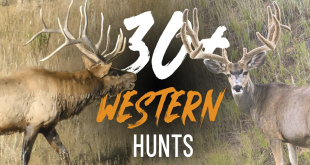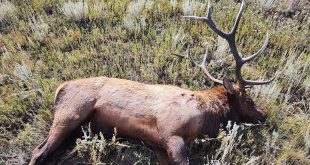Each year, we receive hundreds of story submissions from our nearly 100,000 readers. Of those, we publish about 150 as features. Here’s how to improve your chances of having a feature story published.
Evaluation
Eastmans’ assigns ratings for 1) Photo Quality – respectful hi-resolution, field photos of your trophy and the hunt, 2) Trophy Quality, 3) Story Quality – what the story provides for the reader, and usually publishes stories with the highest combined score. Others may appear in the “Successful Trophy Hunters’” section or on our Eastmans.com website.
Eastmans’ Story Policy
1. All stories must reflect fair chase hunting of trophy western big game. We do not cover Africa, New Zealand or the eastern United States.
2. Submissions MUST be under 2,000 words to be considered for publication and will be eventually be edited down to 1,000-1,600 words.
3. Please try not to promote companies or products inside your story. Use the equipment list for this purpose. You can name the guide, outfitter, or landowner if you choose.
Writing Tips
1. Try to avoid the format of, “I couldn’t believe I was drawn for…,” followed by a completely chronological story, ending with “thanks to…”
2. Tell a true story that is meaningful, unique or engaging. Put your personality into it. Some dialogue is OK.
3. It’s not TV, so paint the scene. Use and try to describe all your senses.
4. Avoid clichés, exclamation points and long paragraphs.
5. Run a spelling/grammar check tool on your story before submission.
6. Don’t worry if you are not a literary pro. Our editors will touch up your story.
Eastmans’ Photo Policy
1. We CANNOT accept photos from cell phones, tablets, or disposable cameras. Period. The resolution on these types of devises is far too small for print reproduction.
2. Minimum individual photo size is 1MB but 3-5MB in JPG or TIFF format is preferred. Keep your camera settings at high resolution (lowest number of pictures) and be sure your computer software doesn’t save them at a lower resolution/size, before you delete your camera SD memory card.
3. Pictures must be free of visible blood, hanging tongues and gut piles. Try to respect the trophy in the photos and do not show, rifles or arrows in the horns, and try to not “ride” your trophy.
4. Take lots of pictures but submit only your 15 best.
Photo Tips
Without a doubt, poor quality pictures are the most common reason a good story does not get published.
1. Picturesque, uncluttered backgrounds are best.
2. Put the sun to the photographer’s back. Your eye may not notice the sun behind you, but the camera certainly will.
3. Get down low, the camera should be at eye level with the trophy or a touch higher. Never shoot a trophy photo from a standing position.
4. Use a tripod or rest like a shooting stick or tree limb as often as practical.
5. Composition – see Mike Eastman’s tips: Background & Lighting, Hunter Placement and Setting up the Photo.
6. Make sure your camera setting is on the highest quality level.
7. For trophy pictures, shoot various poses, angles, and composition. Include other pictures too. Be creative and diverse.
8. Study the photos in EHJ and EBJ. Read Chapter 20 on photography in Mike Eastman’s book, Hunting Trophy Antelope.
Submittal Procedures
1. Email your story to [email protected]. Include a completed online form.
2. Mail a follow-up thumb drive with pictures to: Box 798, Powell, WY 82435. Be sure to reference your first and last name, contact information, state hunted, specie, public land or private, DIY or guided, bow or rifle and story title.
Online Submissions
“Trophy Picture of the Day” or “Reader Stories” can be made online. The total of your picture attachments must be under 1MB. If you have a large, digital photo, contact us.
Email submissions go to [email protected]. Your hunt description must be less than 200 words and put in the email body. Be sure to give your contact information.
Additional Submission Information featured in EHJ Issue 139, MRS Section, Pages 86-87
The first step we take in reviewing any submission is a detailed evaluation that’s comprised of the following three steps in order of priority:
1. Grading photo quality – We like to see image sizes at 3MB or larger taken with a high quality camera. We can use resolutions as low as 1MB but this is not preferable. Photos taken with smart phones or similar devices lack the quality needed for publication. Tip: Take lots of pictures both vertical and horizontal, and send all of them to us. Don’t feel you only need to send the best ones because our designers have creative uses for all of your photos.
2. Trophy quality – This is subjective because different sections of our magazine have different criteria. For instance, a “Younger Generation” submission is more loosely graded than a feature article. Some things to think about are proper trophy positioning, that the photo angles capture the entirety of the animal’s antlers or horns, the tongue is tucked in, excess blood is wiped away, the background is natural, etc. Tip: Pictures of your trophy in the bed or on the tailgate of your truck or ATV will never be published. In some cases this is most unfortunate because they are the best photo angles of your trophy.
3. Story quality – Being third and last on the list may shock some of you, but story quality is not the first thing we look at in the evaluation process. We understand everyone is not a professional writer and we don’t want you to be scared by that fact. We have a dedicated editorial staff that’s here specifically to ensure that the integrity and authenticity of your voice is maintained while making sure our quality standards are met for publication. Tip: Ideal feature length submissions should come in around 1500 words, but don’t let this guide the content of your story. Tell the story you need to tell and we will take care of the rest.
Once the evaluation process is complete, we then determine which section of the magazine it’s best suited for. Here’s a helpful hint – you can save yourself a lot of time in the writing and submission process by first determining which section of the magazine you want to submit to; not all of them have the same requirements. Here’s a quick breakdown of each section and what we like to see.
Feature Article – As stated earlier, features should ideally be around 1500 words, speak to the heart of your experience and have all your hunt photos.
My DIY – Stories should come in around 500 words and be distilled to the center of your hunt and include all supporting photos.
Successful Trophy Hunters/Younger Generation – Include all photos of your trophy and a quick summary of 200 words or less about the trophy, location and any unique circumstances about the hunt or equipment used.
For a comprehensive guide on story submissions and photo tips visit: www.eastmans.com/submit-story.html
 Eastmans' Official Blog | Mule Deer, Antelope, Elk Hunting and Bowhunting Magazine | Eastmans' Hunting Journals
Eastmans' Official Blog | Mule Deer, Antelope, Elk Hunting and Bowhunting Magazine | Eastmans' Hunting Journals






Congratulations. Your family has come a long ways, The hard way Do it yourself business. I used to be a fan of you, Until one time at the Sacramento show, Your dad turn me off, By pushing me aside because he did not, Want to talk to me. He pushed me onto somebody that was working for you there.
That’s not why I’m writing this, Is because a lot of people like me, Cannot go hunting like you do, Because we don’t have the money, i would love to Of been able To hunt like you have, I have consider myself a professional hunter also. But unable to get the chance. I’m 68 now, And running out of time. I living in Nevada, I get out of much possible to take pictures, Of deer and wildlife. Anyway congratulations again I’m taking over the family business And putting out a great magazine. It’s disappointing To read a great article And have no idea where these animals are being taken. What has happened to Taking care of the elderly I have made your business and other business profitable.